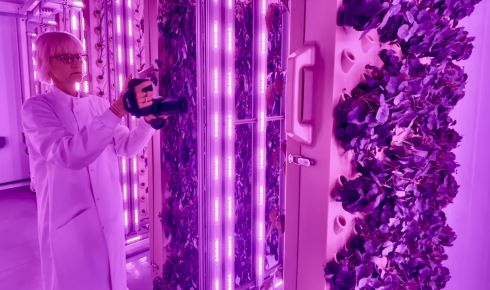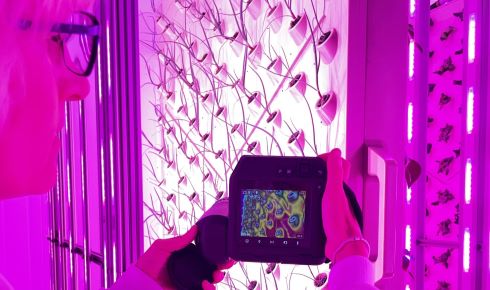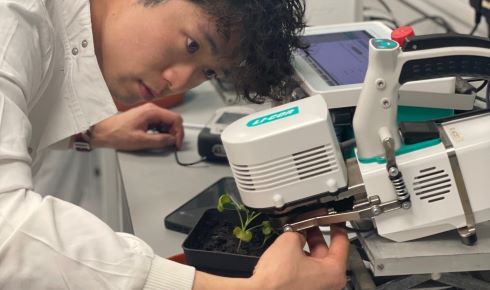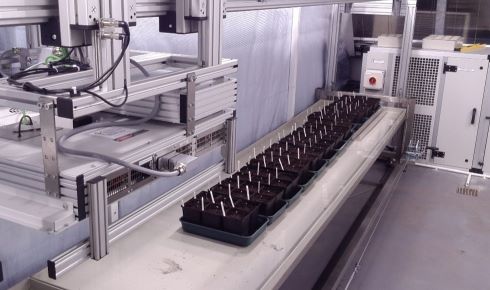Enough about genes—what about ‘phenes’?

6th September 2024
To truly unlock the potential of plants, genomic and molecular advances need to be supported by high-tech plant phenotyping
Advances in genomics have revolutionised plant science, allowing the rapid sequencing of whole genomes, helping to identify molecular mechanisms and physiological processes at the cell, leaf, plant and crop level, and enabling new possibilities in the modification of plants. This is seen as crucial in the goal of enhancing crop resilience and productivity to help feed a growing population as the climate warms.
However, to truly unlock the potential of plants, it is critical to understand how the genome and environment interact to determine the appearance and physiological function of the plant, i.e. its phenotype. Phenotyping plants remains a major challenge, as multiple techniques are employed with no simple way to record, process, store and share data.
Plant ‘phenomics’ combines biology with technology to paint a vivid picture of a plant’s phenotype – that is, its observable characteristics, shaped by its genetic makeup and the environment in which it lives. Analogous to genes, ‘phenes’ represent quantifiable elements of the overall plant phenotype. By collecting vast amounts of data on plant traits, scientists can discern patterns and correlations that hold the key to improving crop resilience, productivity and sustainability.
In the world of agriculture, where challenges such as climate change, pests and resource scarcity loom large, these insights are important. Farmers, breeders and researchers are equipped with a powerful toolset to develop crops that can withstand environmental stresses, maximise yield and contribute to a more secure and sustainable food supply.
 Thermal FLIR camera taking a thermal image of temperature across leaves
Thermal FLIR camera taking a thermal image of temperature across leaves
Leading the way
The UK has significant expertise and capabilities in plant phenomics, with centres of excellence for both indoor and field environments. Recent advances in technology have produced a surge in innovative approaches, technologies and methodologies that allow researchers to delve deeper into phenotypes. High-tech imaging, remote sensing, spectroscopy and even robotics have become the go-to instruments of phenomics scientists.
These technologies offer a non-destructive and efficient means of scrutinising large populations of plants in ways never before possible.
However, the phenomics landscape is fragmented, in terms of geographical location, access and visibility, particularly to plant scientists who have yet to engage, or fully appreciate, the wealth of information and scientific benefits that can be gained from plant phenotyping. Limited technical training and standards of practice make analysing and sharing data and findings complex.
In February 2023, the Biotechnology and Biological Sciences Research Council launched the UK plant and crop phenotyping infrastructure scoping activity, a £2.4m initiative to revolutionise plant phenomics research in the UK. Using this funding, Phenom UK hopes to address the issues above, helping to integrate state-of-the-art national facilities in plant and crop phenotyping and connect the UK plant phenomics community.
Running over the course of two years, the project will design a distributed research infrastructure for plant phenotyping, fostering innovation and catalysing a cultural shift in how the UK approaches plant phenomics. Beyond scientific advances, the initiative seeks to secure the UK’s position as a research powerhouse.
By developing collaboration, innovation and standardisation, PhenomUK aims to provide a transformative solution, transitioning to a national research infrastructure to consolidate resources, bridge gaps and align with international efforts, positioning the UK as a key player in the global plant science community.
 Infra-red gas analysis using a Licor-6800 to measure net CO2 assimilation and stomatal conductance in rocket
Infra-red gas analysis using a Licor-6800 to measure net CO2 assimilation and stomatal conductance in rocket
How you can get involved
PhenomUK is funding a variety of phenotyping activities. Any live funding calls are advertised on
the PhenomUK website and all members of the phenotyping community are strongly encouraged to apply.
As the scientific community strives for increased collaboration and shared knowledge, addressing barriers becomes paramount. By identifying and dismantling them, the research community can pave the way for a new era of collaborative phenomics studies, unlocking the full potential of this transformative field and propelling scientific exploration into uncharted territories.
Plant phenotyping tools and technologies
The plant phenotyping landscape in the UK is rich in innovation and technological advances, with techniques that can assess single plant organs to multiple plants or canopies, both indoors and in the field.
A new generation of glasshouses, protected environments and, more recently, vertical farms or controlled environment agriculture can give scientists unprecedented control over factors such as light intensity and quality, temperature, precipitation and gas composition, as well as the ability to mimic dynamic field environments and impose a myriad of stresses on plants. The fusion of such controlled environment growth facilities with cutting-edge phenotyping techniques opens doors to a range of possibilities to investigate impacts on plant health, crop productivity and yield.
Automated platforms and gantries
Advances in robotics have facilitated the development of automated platforms that have revolutionised the efficiency of phenotyping plants grown indoors and in the field.
Equipped with non-destructive, non-contact sensors, including imaging tools such as multispectral imaging, chlorophyll fluorescence and thermography, these platforms can generate large data sets on morphological and physiological responses of plants over time to combinations of imposed growth conditions and stresses, including future climate scenarios. Field gantry systems in the UK can monitor areas as large as 1,800m2.
The Hounsfield Facility at the University of Nottingham focuses on improving crop plant root systems. Enhancing the efficiency of water and nutrient uptake of crops, both critically influenced by root architecture, can address agricultural challenges, such as water scarcity and the need to reduce fertiliser inputs.
Historically, a major obstacle in identifying the genes that regulate root traits was the inability to image live roots non-invasively. However, advances in x-ray micro computed tomography now enable such root phenotyping. Using x-ray micro computed tomography imaging, biological image analysis, wheat genetics and mathematical modelling, researchers at Nottingham are beginning to identify key genes to develop molecular markers and new crop varieties with enhanced nutrient and water uptake efficiency, as well as elucidating the mechanisms by which roots respond to soil compaction caused by modern agricultural practices.
A fully automated phenotyping platform allows researchers to select and breed wheat varieties with such superior root traits.
Portable tools and bespoke techniques
Portable field phenotyping tools are enabling researchers to explore agricultural landscapes with unprecedented precision and efficiency. For instance, drones equipped with high-resolution imaging sensors (including RGB, thermal, hyper and multispectral and electronic noses for sniffing volatiles), enable phenotyping of plants in remote and challenging field conditions. New hand-held 3D scanners offer swift and efficient monitoring of crop growth or chemical composition both indoors and outdoors. Although portable, these analysers can be time-consuming to operate.
Digital infrastructure
As AI gains prominence and becomes increasingly pervasive, large phenotyping data sets represent a great opportunity for AI-driven trait analysis in key agricultural and horticultural crops. Rapid analysis of new and existing data with AI can streamline the identification of natural variation, paving the way for targeted genetic and breeding strategies.
The ability to store, process and share data in a seamless manner will not only enable and empower a future of AI-driven phenotypic extraction, but can also enable comparisons across different technologies and locations, for instance, comparing thermal images captured via a drone with those from a hand-held camera. This compatibility is essential for developing a shared community resource akin to those existing for genomics. Addressing this challenge is a key focus of the PhenomUK Research Infrastructure programme.
 Thermal imaging platform at the University of Sheffield
Thermal imaging platform at the University of Sheffield
Remaining challenges
A more comprehensive assessment of numerous physiological parameters, essential for enhancing crop productivity, requires further development. Measurements of photosynthesis and transpiration can be determined using chlorophyll fluorescence, and indirectly via thermography, but ‘gold-standard’ measurements still rely on relatively costly infra-red gas analysers (IRGAs) that are difficult to deploy at scale. Automated IRGAs have the potential to increase throughput.
Measurements below ground are also particularly challenging due to the opacity of soil. Automated analysis of plants grown in rhizotrons can provide a low-cost approach, whereas X-ray micro computed tomography, coupled with advanced data extraction techniques, provides improved insight into root structure, albeit at relatively high cost and low throughput.
For more information, visit PhenomUK
Professor Tracy Lawson is a plant physiologist and director of plant phenotyping at the University of Essex and a lead on the PhenomUK Access Strand. Her research focuses on the stomatal control of photosynthesis and water loss.
Professor Stephen Rolfe is a chair in plant science at the University of Sheffield and runs the Wolfson Centre for Disease Phenotyping. He is also a lead on the PhenomUK Access Strand.
Gemma Bray is a biologist and data scientist. She is surveying the UK plant phenomics community to gain insight into the current UK infrastructure and running the PhenomUK access trials.
Dr Tanja A Hofmann is an environmental biologist and senior research fellow at the University of Essex. She is contributing to surveying the UK phenomics community and outreach.


